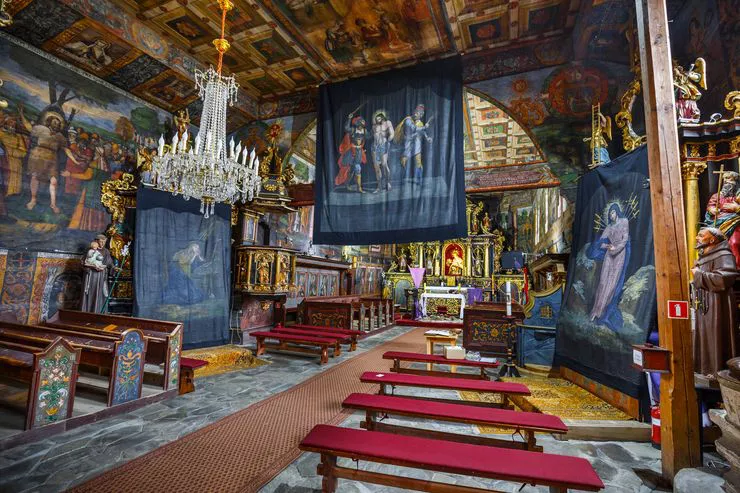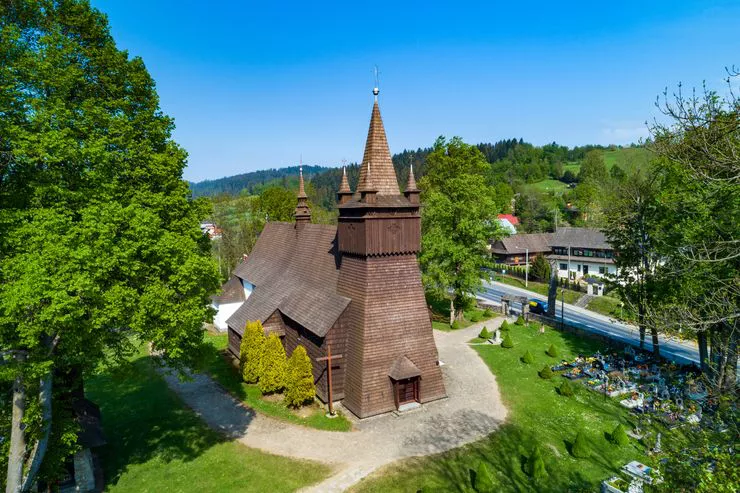





Medieval history glimpsed through the Lenten veil.
In the Middle Ages, Lent, known especially in the East as the Great Fast, was a time of deep reflection and mourning, as people focused on the Passion of Christ. All forms of entertainment were prohibited, organs in churches fell silent, flower decorations were forbidden, as were weddings and other celebrations of joy. Many communities adopted the practice of visually separating the congregation from the most sacred spaces of the church.

The cloth used for this purpose was known as the Velum Quadrigesimale, which is Latin for the Lenten Veil. It was a large curtain, richly adorned with symbols of the Passion and Crucifixion, that hung in front of the altar from Ash Wednesday until Easter Saturday. Once widespread across Europe, this tradition has largely faded, even in Poland, where only violet veils are commonly placed over crucifixes from the fifth Sunday of Lent onwards. However, this ancient Lenten tradition is still observed in a few locations, including the village of Orawka in southern Małopolska, which boasts a collection of four Lenten curtains depicting entire Passion scenes, locally called “opony”. The oldest and largest, The Pieta under the Cross, dates back to 1676, while the other three from the early 19th century feature other scenes from the New Testament: The Scourging of Christ, Penitent Mary Magdalene, and Our Lady of the Seven Sorrows.
The Church of St John the Baptist in Orawka itself is a historic parish church on the Małopolska Wooden Architecture Trail. Built from 1650 or 1651 to 1656 amidst trees and surrounded by a wall enclosing a cemetery, it is the oldest church of the first Polish parish in Orawa and the oldest wooden church in Upper Orawa. Its significance in the cultural history of the region is profound, and it stands out with exceptional artistic qualities. Especially noteworthy are its traditional architecture and the exceptionally rich artistic interior, particularly the exquisite polychrome wall paintings from the 17th and 18th centuries.
In 2024, the curtains will be displayed from 16 to 24 March. They can be admired for about half an hour before daily services, whose times are listed on the Orawka parish website. Additional viewings have been slated for Saturday, 16 March from 1:00 pm to 4:45 pm; Sunday, 17 March from 12:00 pm to 2:15 pm; Saturday, 23 March from 10:00 am to 4:45 pm, and Sunday, 24 March from 11:30 am to 2:15 pm.
Now all but forgotten, in the 13th century Lenten veils were obligatory in the dioceses of Exeter (since 1217), Canterbury, Winchester, Evreux, and Oxford.
The remaining four curtains have been preserved in two other churches on the Wooden Architecture Route in Małopolska: the Church of the Holy Trinity and St Anthony Abbot in Łopuszna and in the Church of the Visitation of the Blessed Virgin Mary in Tłuczań, near Wadowice.
By the regulation of the President of the Republic of Poland from 2021, the Church of St John the Baptist in Orawka was declared a historical monument and, as such, is under special protection. This status had previously been granted to only 109 places in Poland.
The Church of St John the Baptist in Orawka has also been nominated for inclusion on the UNESCO World Heritage List.








